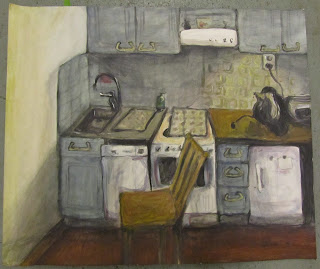Last summer I was working in the most interesting museum in Helsinki,
Seurasaari. It is placed in a beautiful island. It basicly consists of old relocated houses, cottages, farmsteads
and manors, with traditional interiors. The houses are from from 17th to 20th century and they are moved from different places in Finland. Houses are from rural areas, and the habitants were mostly farmers.
 |
| Storage houses |
 |
| Place for washing hands |
 |
| Wealthy peasant house, Ivars |
 |
| Fancy bedroom of the oldest daughter, Antti farmhouse |
I was working as a guide attendant. My job was to give customer service, guide visitors, do history reenactment, organize workshops, open and close the houses, sell tickets and keep an eye on the houses. Workers had beautiful costumes, and most of us were also performing in some way. One girl was playing
kantele and one was singing traditional songs. Most of us could do some handicrafts, for example crochet, knitting, spinning, ribbons, wood works etc.
 |
| The view from the window of my workplace |
I was spinning yarn most of the time. I used a spindle, because it was easy to carry around. I could also stand while spinning. Spindle is one of the most primitive tools for making yarn. Spinning wheel is more new, and more efficient tool to make yarn. In Finland the spinning wheel started to replace spindles slowly from the 18th century, but in the most isolated places in Carelia people used spindle as late as early 1900's. Those of you who have spun ever, know that I had to also card, twine, wind a skein and wash the yarn, for completing the process. I liked to teatch some visitors to card, and even to spin.
 |
| I'm spinning in Pertinotsa, Carelian house |
 |
| Yarns I've spun, and some wool and flax |
 |
| Spindles, Carders, Skein winder |
Every house contained a large folder, which contained information about the house and habitants. There were also some general history and folklore, information about crafts, habits, religion, food etc. I was so excited about my work, that the first months I studied a lot folklore, and learnt enormously much. My mom is folklorist, so I borrowed her books and asked about everything. As I was spending most of the time indoors, I was surrounded by collection of weird objects and furniture. I studied the names and functions of each object from an inventory list which was placed in the folder.
 |
| Spoons are licked clean and then put to dry in a rack |
 |
| Textile craft related tools |
It was also interesting to see completely different floorplans, interior and decorations. Entry rooms were usually huge, and buildings seemed to have a "main room", which served many functions. In some of the houses in Seurasaari, the main room is a living room, bedroom and kitchen same time, even when the house is full of other large rooms for storage, visitors and parties. There were long benches next to the wall and the women's and men's sides in the rooms.The different kinds of stoves affected to the food culture and vice versa. There was huge selection of interesting interior fabrics, and old ways to use them.
 |
| Rag rug |
 |
| Bed curtain, to keep warmth, and to create privacy |



















































